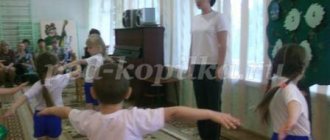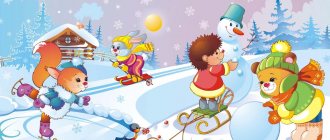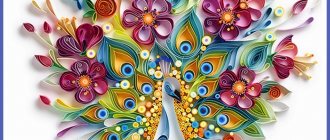Preparatory group. Senior preschool age. Children 6-7 years old
Summary of a lesson on familiarization with the outside world “Wintering Birds” for the preparatory group Notes of a lesson on familiarization with the outside world “Wintering Birds”
for the preparatory group.
Goals and objectives Educational: clarify with children about the life of wintering birds. Develop bird watching skills and abilities.
Developing: to activate and expand the vocabulary, correctly... Summary of educational activities on the surrounding world in the preparatory group “Nature in Winter” Summary of educational activities on the surrounding world in the preparatory group “Nature in Winter” Developed by Elena Vladimirovna (teacher at MBDOU No. 49)
Goals: 1.
Shape children's ideas about the adaptation of trees to winter conditions. 2. Raise children...
Summary of a lesson on familiarization with the outside world in the preparatory group “MAGICAL NEW YEAR”
Notes on getting to know the world around you
in the preparatory group Topic:
"Magical New Year"
TEACHER: TSYGANKOVA O.M.
Target:
to form ideas about the New Year as a cheerful and good holiday.
Tasks:
•Enrich ideas about the celebration of the New Year, about the symbols and traditions of the holiday; •Continue to teach how to solve riddles; •Teach to give complete and detailed answers; •Develop children’s play activities. Types of children’s activities: social and communicative activities, cognitive activities, reading fiction. Vocabulary work: festive, glass, sparkling, silver, fluffy, New Year's, elegant, snowy, cold, icy, long-awaited. Preliminary work: Have a conversation with the children about the New Year holiday; remember how to decorate a Christmas tree. Materials and equipment: pictures on cardboard depicting Christmas tree decorations and other items.
GCD move:
“Cold weather has set in. The water turned into ice. The long-eared gray bunny turned into a white bunny. The bear stopped roaring: The bear fell into hibernation in the forest. Who can say, who knows, When this happens? »
What time of year is the riddle talking about? - (about winter) What are the winter months called? – (December, January, February). What happens in nature in winter? (children's answers according to the picture-graphic plan: sun, sky, trees, birds, animals, people) Many beautiful words can be said about winter. What words will you choose?
Game "Words on the Palm"
“I open my palm, I accept your words” (children select words-signs: snowy, cold, icy, long-awaited, etc.) Game “Without which there is no winter” Now tell me, without what there is no winter? (there is no winter without snow, snowdrifts, icicles, frost, sleds, slides). What holidays do we celebrate in winter? (someone’s birthday, New Year, Christmas, Defenders of the Fatherland Day) What is your favorite holiday? Of course New Year! Educator: Father Frost and Snow Maiden come to our Christmas tree on New Year's Eve. In what month? Children: In December. Educator: How do people celebrate the New Year? Children: They decorate the Christmas tree, give gifts to each other, have fun around the tree. Educator: How and with what do they decorate the Christmas tree? Children: They hang up toys. Educator: Toys that hang on the Christmas tree, what are they called? Children: Christmas tree toys. Educator: What kind of Christmas tree toys do you decorate the Christmas tree at home? Children: Multi-colored balls, garlands, etc. Educator: New Year is one of the most fun holidays. He is always greeted in a good, cheerful mood. Do you know how the New Year holiday appeared? In ancient times, for many peoples, the year began in spring or autumn. In Ancient Rus', the new year began in March. It was greeted as a holiday of spring, sun, warmth, and anticipation of a new harvest. And more than 300 years ago (on the eve of 1700), Russian Tsar Peter I issued a decree to celebrate the New Year according to a different custom (European) - January 1. Peter invited everyone to decorate their houses with pine and spruce branches. Everyone had to congratulate their relatives and friends on the holiday. At 12 o'clock at night, Peter I went out onto the square with a torch in his hands and launched the first rocket into the sky. Thus began the fireworks in honor of the New Year holiday. About three hundred years ago, people believed that by decorating the New Year tree, they made evil forces kinder. The evil forces have long been forgotten, but the tree is still a symbol of the New Year holiday.
Game “Which one? Which? Which?"
Guys, look carefully at the pictures and say as many words as possible about this subject.
Garland (what) - new, beautiful, shiny, multi-colored... Tinsel (what) - shiny, New Year's, silver... Toy (what) - beautiful, glass, round, New Year's... Santa Claus (what) - fabulous, huge, kind, cheerful ...The Snow Maiden (what) is beautiful, kind, cheerful...The holiday (what) is cheerful, noisy, magical, memorable...New Year's tree, festive, fluffy, decorated, elegant.
Game "This way or that way"
I will read the sentences, and you listen, find the mistakes in them and name the sentence correctly. The mask likes to wear Masha. The Christmas tree is dancing near the Snow Maiden. The children decorated the toys with Christmas trees. The Christmas tree lit up with light bulbs. Santa Claus brought a bag of gifts. A conversation about how New Year is celebrated in different countries. Educator: How the New Year is celebrated in different countries, I will tell you now. English Santa Claus travels on a sleigh pulled by six reindeer.
Everyone is looking forward to it, especially the children. They hang a stocking on the edge of their bed, into which a gift should fall through the chimney. In France, children are waiting for the French Father Christmas (Père Noël).
He divides gifts for children into two parts: he leaves some gifts on New Year's Eve, and puts more valuable ones in prepared shoes (the children hang them in the house in the evening) on Christmas Day. In Germany, the German Father Frost (Weinachtsman) gives gifts on New Year's Day. He holds gifts in one hand and rods in the other.
As expected, those who behaved well receive a gift. Anyone who behaved badly and played a lot of pranks during the year will not see a gift. In Japan, every child on New Year's Eve puts a drawing of his “dream” under his pillow and they believe that then their dreams will definitely come true. In Russia, the New Year is always dressed up Christmas tree, festive dinner, chiming clock, Snow Maiden and, of course, Father Frost, who puts gifts for children under the Christmas tree on New Year's Eve. And what gifts to give children for the New Year, Santa Claus learns from the letters he receives from children just before the holiday.
Educator: New Year will come soon in our country. How do you guys usually celebrate the New Year? Children: children's answers.
Game "Dress up the Christmas tree."
Educator: Now we guys will play the game “Dress up the Christmas tree” and find out who can decorate the New Year tree correctly and quickly. The teacher divides the group into 2 teams and opens a board on which 2 Christmas trees are drawn. In front of the teams on the tables are pictures cut out of cardboard with images of various objects. Team No. 1: balls, stars, icicles, fox, bunny, stool, nail, skates. Team No. 2: balls, stars, Santa Claus, Snow Maiden, candy, hammer, plate, trousers. Educator: Your task, guys, is to decorate the Christmas tree as quickly as possible. Pictures need to be attached to the tree with magnets, which you will see on the board next to the tree. The winner is the team that not only decorates the Christmas tree faster, but also correctly. Not all objects that you see in front of you are suitable for decorating a Christmas tree. Be careful. A game is being played. The guys sum up the results of the game themselves.
Puzzles
And now, guys, let's guess the New Year's riddles! The Christmas tree on New Year's Day calls adults and children. Invites all the people to New Year's... (round dance). Everywhere on this holiday there is a roar! An explosion, followed by cheerful laughter! A very noisy toy - New Year's... (cracker. )Santa Claus came to visit us with a fragile, snow-white guest. He called her little daughter. This girl... (Snow Maiden). She sparkles in the skies, decorates our Christmas tree. It will never fade on New Year's Day... (star). On New Year's Day we are not sad , We are sitting under the Christmas tree And we say to each other with expression... (congratulations). How do people congratulate each other on New Year's Day? (They give gifts, send greeting cards, parcels, letters, make phone calls, etc.) Let's prepare a holiday greeting, what do we wish to our family and friends? (children's statements).
Result of GCD: Educator: Guys, did you like our lesson? What? Children: We learned what Santa Clauses are like in different countries of the world. We played interesting games. Educator: Which game did you like best? Children: children’s answers. Educator: Well, our New Year’s adventure has come to an end. Happy New Year to you all!
Goal: to introduce children to traditional Russian folk holidays. Educational field: Cognition. Formation of a holistic picture of the world, expansion of horizons “Traditions of the Russian people” Objectives:
- teach children to share their impressions with others using artistic means of expression;
- instill in children a love for traditional holidays;
- develop in children the ability to distinguish and understand the names of holidays.
Materials: Semenov nesting dolls, samples of colored ornaments from Polkhov - Maidan painting, silhouettes of nesting dolls cut out of paper, gouache, brushes, water, napkins. Progress Educator: Our ancestors loved and knew how to have fun. Do you guys like holidays? And why? What holidays do you know? Children: Yes. Holidays are magical and fun. New Year, Christmas, Easter... Educator: Well done, you know many holidays that have been known since the time of our ancestors. Who do you think the ancestors are? Children: Ancestors are those people who lived before us. Educator: Our ancestors - the Russian people - always revered holidays, but they celebrated them differently, not like we, modern people. Do you want to know how? Children: Yes. Educator: Then let's take you on an excursion into the past.
You ask how? Sit down on the carpet, close your eyes, we are going on a journey through the past. Music sounds, a screen opens and the scenery appears: on the one hand, a Russian hut and a birch tree, on the other, a church, paintings and scenes from the life of the Russian people. Educator: Usually all holidays began with a solemn service in the church, and continued on the street, in the field, on the lawns.
To the music of pipes, balalaikas, and accordions, they danced in circles, sang, danced, and started games. People dressed up in their best holiday clothes.
The festive meal was prepared in a special way. They gave gifts to the poor and poor people and fed them free food.
The festive ringing of bells could be heard everywhere.
All holidays in Rus' were divided into great, medium and small. Some were celebrated annually and on the same days, others - annually, but on different dates of the month.
The greatest and most beloved holiday was Easter. It was called the Feast of Feasts and the Celebration of Celebrations. This holiday was celebrated solemnly and cheerfully. It was celebrated for a whole week. On Easter night everyone went to church, only small children and very old people remained at home. Bonfires and colored lanterns were lit near the church. Returning from church early in the morning, people kissed, said Christ and exchanged colored eggs.
The red egg is a symbol of Easter. People have created a whole art of coloring eggs. Approach the exhibition. The teacher offers illustrations and photos. Educator: Here are eggs that were made from glass, wood, crystal, porcelain, bone, clay, sewn and embroidered with pearls and beads. Confectionery shops sold chocolate and sugar eggs. A lot of eggs were made - for gifts to family and friends, for games. Do you want us to play too? Children: We want. Educator: Here we have a slide made from a board. Small toys are laid out under the slide on a flat area. Everyone rolls their own egg down the hill. And, if it touches any toy, then the child receives this toy as a gift. is being played . Educator: The bells rang throughout Easter week. Those who wished could climb the bell tower and ring the bells. Carousels were installed in the squares and competitions were held. People visited each other and the whole week passed in joyful meetings. Guys, did you like the story about Easter? Children: I liked it. Educator : What other Russian folk holiday do you know? Children: Christmas. Educator: That's right, it's Christmas. Would you like me to tell you how Christmas was celebrated in Rus'? Children: We want. Educator: This holiday was also one of the most famous and beloved. Holy evenings began on January 7 and ended on January 19. Perhaps there is no other holiday that would be distinguished by such an abundance of customs, rituals, and signs. Previously, in Rus', Christmastide coincided with the New Year, with the New Year tree, dressing up, dressing up, telling fortunes for girls, dancing, and general fun. Children look at the illustrations. Educator: For two weeks people went from house to house, praising Christ, singing carols, singing songs, and eating food. Bonfires were lit in the streets to increase light and warmth, they baked figurines of animals and birds from dough, and gave them to each other. Guys, do you want to know why they decorate the Christmas tree for Christmas and New Year? Educator: Then listen carefully. When Jesus Christ was born, not only people, but also the trees growing near the cave rejoiced at this event. Three trees were the happiest of all. They grew closest to everyone and they could clearly see both the manger and the Baby.
These were palm, olive and modest spruce.
“Let us go, worship the Child and offer him our gifts,” said the Palm to the Maslina.
“Take me with you,” Elka asked.
“What gifts can you give? Thorny needles and sticky resin,” answered Palma and Maslina.
An angel heard this conversation and decided to help the humble spruce.
The palm tree bent over the Baby and gave away the best leaf from its crown. “Let it cool you on a hot day,” Palma said.
The olive tree bent its branches, fragrant oil dripped from them, and the whole cave was filled with fragrance.
And the tree stood to the side and was sad. But the Angel said to her: “For your modesty, I will decorate you better than your sisters.” The angel made a sign, and one after another, stars began to roll down from the sky onto the green branches of the spruce tree, and the whole tree began to shine with brilliant lights.
And when the Child woke up, it was not the fragrance in the cave, not the luxurious fan of the palm tree that attracted His attention, but the shining tree.
He smiled and extended his hands to her. The tree did not become proud and tried to illuminate its friends – the palm tree and the olive tree – with its radiance.
And the Angel said: “You are a good tree, and for this every year you will show off in the radiance of lights, and little children will rejoice and have fun, looking at you.” Educator: Guys, now come here and look at these pictures. Illustrations of folk festivities on Maslenitsa are shown. Educator: What holiday do you think is depicted in them? Children: Maslenitsa. The teacher and the children remember how they celebrated Maslenitsa in kindergarten. Educator: Are you my soul, my Maslenitsa, your sugar lips, your sweet speech. Come visit me in the wide yard, ride in the mountains, roll around in pancakes, amuse your heart. After such words, Maslenitsa left, and the fun began. People walked for a week, each day had its own name: Monday - “meeting”; Tuesday – “fun” Wednesday – “turn”; Thursday – “wide”; Friday – “mother-in-law’s evening”; Saturday – “gatherings”;
Sunday is “forgiveness day.” On the eve of the first day of Maslenitsa, housewives begin baking pancakes. The traditional pancake was not just a piece of fried dough, but a symbol of the red sun. The first pancake was given to a beggar to commemorate deceased ancestors. In the spring, in May, people greeted spring together, decorated birch trees, and wove flower wreaths. This is how our ancestors celebrated their holidays. Which holiday did you like best? What do you remember? And now, guys, I suggest you draw your favorite episode of any Russian folk holiday.
Making tasks more difficult
When organizing such activities, it is important for the teacher to create an atmosphere in the group in which each child will be able to realize his own activity. In addition, games conducted by the teacher can be more complicated. This can be achieved using one of the following methods:
- include in the lessons a “journey” of children into the past, as well as into the present and future of the objects in question (depending on the age of the preschoolers):
- increase the number of such “travels”;
- change the number of teams and participants in each of them;
- include a task for drawing the subject being studied, etc.
The use of didactic games by a teacher can be carried out not only in the course of the general activities of the teacher and children. Preschoolers are often involved in independent work. This makes it possible to stimulate their activity in the process of studying the world around them.
Children attending the preparatory group of a kindergarten must be able to act independently based on a given algorithm, and after receiving the result, be ready to draw up their own course of action based on the proposed model.
The main goal of such classes is to teach preschoolers the ability to determine the properties and structure, characteristics of objects, as well as the features of the interaction of their characteristics, presenting everything in a general system of interdependencies and relationships (functioning and structure, purpose and existence in space and time). Let's look at sample topics for classes.
Study of physical phenomena
For such classes, the teacher will not need a laser, oscilloscope or synchrophatron. A preschooler needs to be introduced to the phenomenon of floating bodies. To do this, various objects are lowered into a basin of water. As a result of the experiment, the child finds out which of them sinks and which remains on the surface.
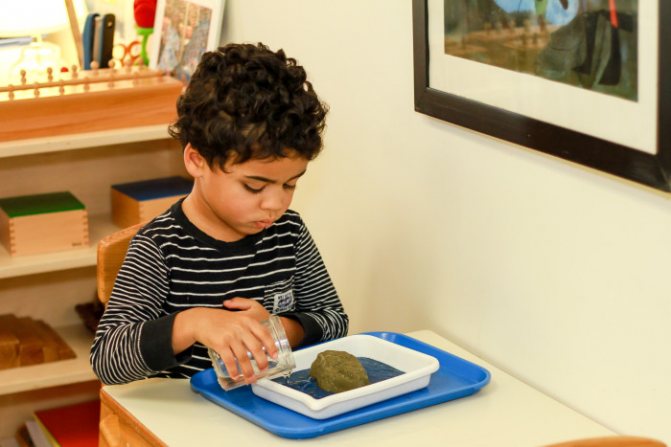
Other experiments may be carried out. For example, by dissolving a substance in water. For this you will need a glass. Warm water is poured into it. A spoonful of sugar or salt is poured into a glass. First, the teacher should ask the children what they think will happen next. Most likely they will be able to answer correctly. Yes, the sugar or salt has dissolved. Maybe they have completely disappeared? No. Children must understand that substances have changed into another state.
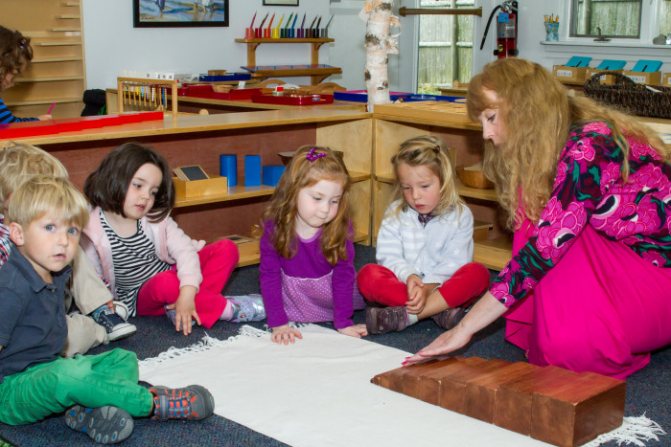
Familiarity with physical phenomena gives children an understanding of the properties of various materials. Some of them are solid (stone, wood, metal). If you put pressure on them, they will not change their shape. There are also soft materials. These are cotton wool, fabric and plasticine. When pressed, their shape changes quite easily. There are also materials that feel hard to the touch (faience, glass), but can easily break.
